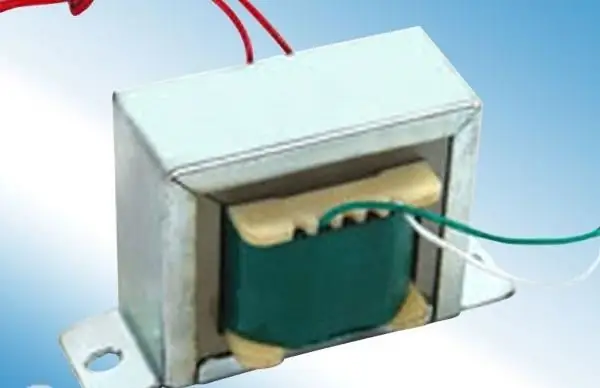2026 Author: Howard Calhoun | [email protected]. Last modified: 2025-06-01 07:12:56
There is an old institute joke. To the question of the teacher “how does a single-phase transformer work”, the student buzzes in response: “Uuu!”. Such a sound really takes place, but it is due to the fact that when the inductive field is directed, a magnetic-striction effect occurs, causing the plates of the magnetic circuit to vibrate.

A single-phase transformer is designed to provide the right amount of AC voltage for a load that does not need a three-phase power supply.
Any transformer consists of two main units: a core and coils, there are at least two of them. The principle of operation is simple. As a result of the passage of electric current through the conductor in the primary winding, an electromotive force (EMF) is induced on the secondary. The core consists of ferromagnetic plates, that is, a material that enhances the magnetic field (electrical steel of special grades).
The EMF value is determined by the formula:
E=4, 44 x F x f x ω

where:
F -magnetic flux amplitude;
f - current frequency;
ω is the number of turns in the winding.
The allowable load power that a single-phase transformer will “pull” is given by the cross section of the wire with which the coils are wound, and the quality factor of the magnetic circuit, in particular, the magnetic permeability of the ferromagnet µ. The dimensions of the core and the number of turns are the subject of calculation, which is often the subject of term papers in technical universities.
In any case, the more powerful single-phase voltage transformers, the more impressive their size. On their case, most often there is a label listing the main parameters (permissible current, input and output voltages). However, this is not always the case.

In practice, many repairers are often faced with the need to replace a burned-out single-phase voltage transformer. To ensure suitability, the specifications of the replacement device should be examined.
The first thing to do is to define the input winding. For step-down transformers, it has the highest resistance.
Then, by plugging it into the network, you can measure the output voltage in idle mode. The ratio of the input and output EMF is the transformation ratio K. It is also equal to the fraction N in / N out, that is, the number of turns in the windings.

After that, you can connect a powerful variable resistance (rheostat) as a load and take the current-voltage characteristic by determining the valuerated current. As the load increases, the output voltage gradually drops.
Transformers are not only power, but also measuring. In cases where it is necessary to determine a significant amount of current in the circuit, an ammeter is used. It is connected in series and should have a low resistance combined with a large wire gauge in the magnetic deflection system. Such a device would be too massive and expensive, therefore, single-phase current transformers are used, which take proportionally reduced values and feed them to ordinary serial ammeters. It is not difficult to calculate the amperage, it remains only to apply the multipliers indicated on the case.
Recommended:
The main purpose of budgeting. The concept, essence of the process and tasks of budgeting

What is the main purpose of budgeting? Why is this process taking place? Why is it needed? What tasks are being performed? What is the essence of this process? How is the overall system structured? These, as well as a number of other questions, will be answered in the framework of the article
Main operating materials: types, characteristics, purpose

Automotive equipment cannot work without fuel, lubricants and other materials. They have a number of special characteristics that depend on the features of the system. Operating materials correspond to the model of vehicles, perform many functions in the process of application. What they are, how they differ, will be discussed further
Single-pole machine: device, specifications and connection features

In order to choose the right single-pole machine without errors, you should understand the markings printed on the case on the front side. The characteristics of the device are selected depending on the type of connected load and the cross section of the wiring
Mast transformer substation: principle of operation and purpose

The article is devoted to mast transformer substations. The device, principle of operation, types and purpose of such equipment are considered
Device and purpose of the current transformer

The article is devoted to current transformers. The device, purpose, principle of operation and varieties of this equipment are considered

